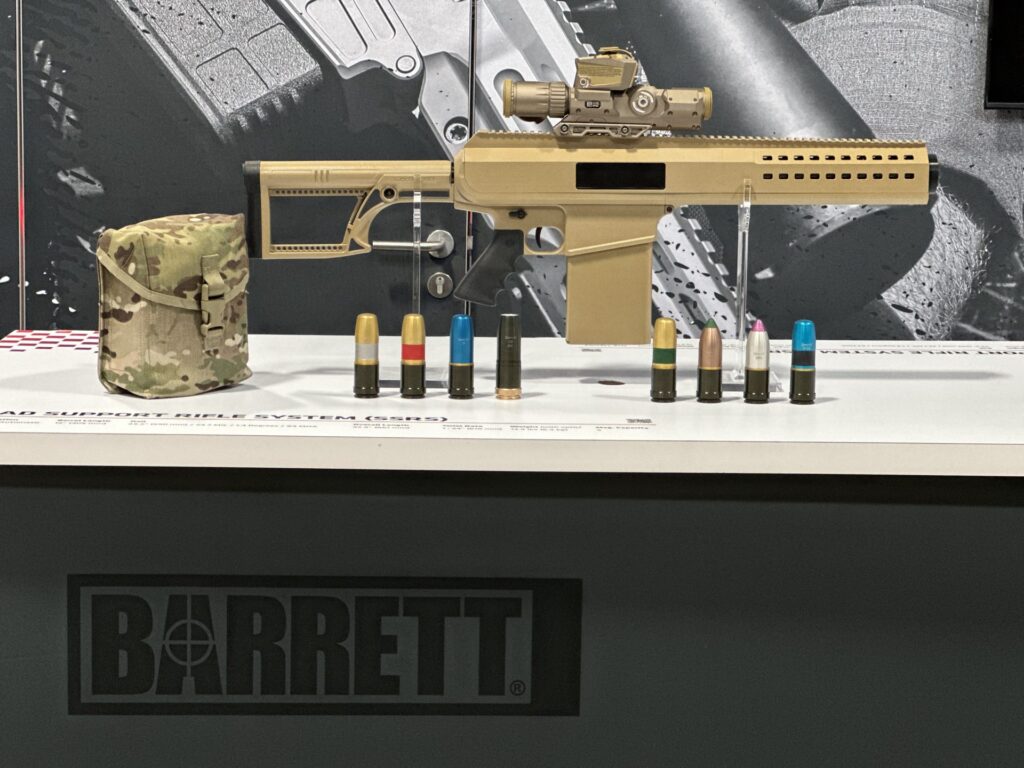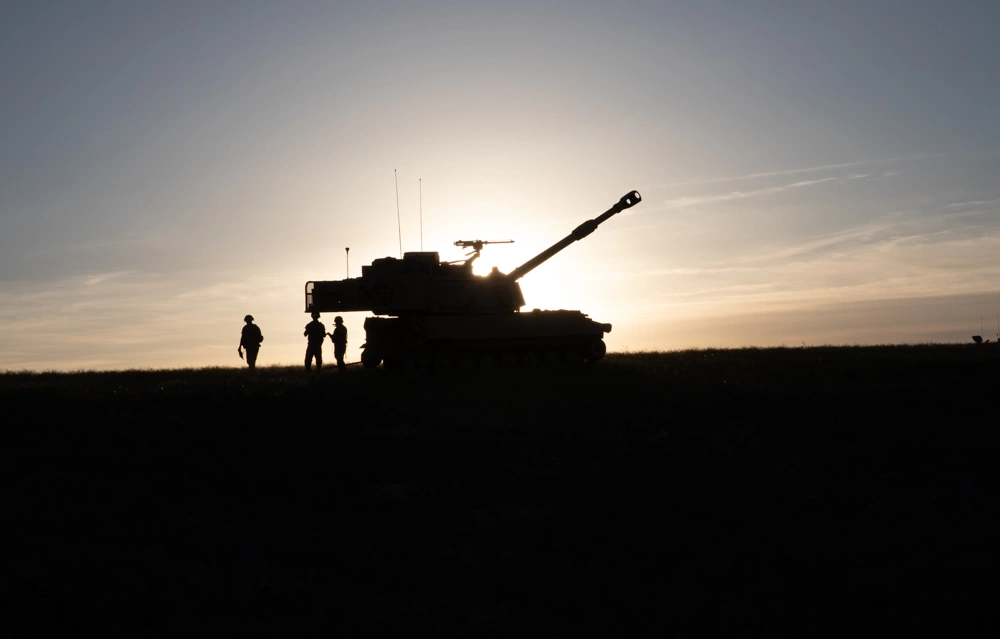The chain gun is an incredibly reliable and powerful weapon
- By Travis Pike
Share This Article

I was first introduced to the term chain gun by Doom. The chain gun in Doom was a powerful, hard-hitting machine gun that ate ammo like I eat pizza bagels.
These guns are also called autocannons and are in the same family of weapons as the minigun. The lightest autocannon is an atypical experimental British 7.62x51mm gun that weighs 39 pounds. Usually, these guns weigh anywhere from 76 to 437 pounds. They are massive weapons intended to be used on vehicles, both ground and aerial.
What’s a chain gun?
A chain gun or autocannon is a weapon that uses a chain driven by an electric motor to cycle the weapon. Typically the chain moves around a rectangular circuit with sprockets to apply tension. The links of the chain control the weapon’s extraction, loading, bolt movement, and how long the bolt remains closed between shots; the gun only depends on this electrically driven chain to operate. The motor can be anywhere from one horsepower to five horsepower for the larger guns.
The rate of fire is typically determined by how long it takes for the chain to make a complete loop around the rectangle. This allows the user to vary the chain’s motor speed, which can increase or decrease the rate of fire substantially. Usually, these weapons will have a few different settings that are user-controlled and likely incorporated into a unit’s tactics.
Weapons like the minigun series also rely on an electronic motor and they do qualify as autocannons. However, these are not chain guns. We find ourselves in situations where all chain guns are autocannons, but not all autocannons are chain guns.
Typically, these massive firearms will fire a massive 20mm to 50mm projectile that explodes on contact. There are also .50 BMG and 7.62 chain guns, but they aren’t fielded extensively.
Why are they used?

Your average automatic firearm uses some form of gas or recoil energy to cycle. The M16, for example, siphons off gas from a fire round to operate. This is a very efficient and effective system that’s well-proven. The downside is that this opens up the weapon to failures that require a shooter to physically fix the issue, as a result, troops are taught procedures like Tap Rack Bang to fix these issues.
However, following the Tap Rack Bang on a weapon that uses gas or recoil to function and is placed on the outside of a vehicle is hard or impossible: you can’t exactly pop out and apply the Tack Rack Bang on an Apache. Also, with some guns, the cartridges are so big and powerful that the average person isn’t strong enough to manually operate the action.
This is why the chain gun entered the picture.
Related: A Green Beret remembers his favorite foreign weapons
Maximum reliability

None of the above is a concern with a chain gun. If the weapon fails to fire a cartridge, it won’t fail to extract or eject because an electric motor is forcing it to function. With a chain gun on your Armored Personnel Carrier or attack helicopter you’re ensured that there won’t be any stoppages and you can just keep firing. No need for a user to jump out and try and do the old Tap, Rack, Bang.
Also, the motor and chain make it easy to activate the massive part necessary to feed a weapon that weighs over 400 pounds and fires a 50mm projectile.
These weapons are incredibly reliable, and during testing by the Naval Surface Weapons Center in 1983, the Navy stated:
“29,721 rounds of endurance tests were fired with no parts breakage and without any gun stoppages. It is significant that during firing of 101,343 rounds, not one jam or stoppage occurred due to loss of round control in the gun or feeder mechanism [this] is in our experience very unusual in any weapon of any caliber or type.”
Related: Fear the REAPR – The Ohio Ordnance machine gun
Who uses them?

The United States uses them extensively, as do many Western European countries. They are commonly found on helicopters, naval vessels, and fighting vehicles. The U.S. Marine Corps equips an M242 Bushmaster to its LAV-25 armored reconnaissance vehicle, and the Army uses the same gun on the M2 Bradley. The AH-64 Apache uses a 30mm M230 to provide intensive fire on ground targets.
These massive autocannons can be used for numerous engagements. They are effective against lightly armored enemy forces and will shred an unarmored vehicle. In Desert Storm, the M2 Bradley hunted Soviet tanks and dispatched them with its M242 and TOWs.
These guns can penetrate and eradicate hard cover, as well as engage threats from extended distances. They can have an effective range of 3,000 meters and deliver a punishing round on contact. Throughout the Global War on Terror, they were used to outgun and outmaneuver an enemy, and with the U.S. sending M2s to Ukraine, they are being operated in a peer-to-peer conflict.
The chain gun is a unique weapon that brings massive firepower to the fight. These electronically-driven guns offer a unique advantage in situations where the extra weight of a motor is worth it.
This article was originally published in March 2023. It has been edited for republication.
Read more from Sandboxx News
- Lock-picking 101 with the Delta Force
- Hermeus reveals flying prototype in its pursuit of a reusable hypersonic jet
- The Army doesn’t have enough PSYOP soldiers to fight the information war, inspector general says
- What really happened when F-22 Raptors squared off against the Eurofighter Typhoon?
- Built over 150 years ago, the first machine gun is still influential
Related Posts
Sandboxx News Merch
-

‘AirPower’ Classic Hoodie
$46.00 – $48.00 Select options This product has multiple variants. The options may be chosen on the product page -

‘Sandboxx News’ Trucker Cap
$27.00 Select options This product has multiple variants. The options may be chosen on the product page -

‘Kinetic Diplomacy’ Bumper Sticker (Black)
$8.00 Add to cart

Travis Pike
Travis Pike is a former Marine Machine gunner who served with 2nd Bn 2nd Marines for 5 years. He deployed in 2009 to Afghanistan and again in 2011 with the 22nd MEU(SOC) during a record-setting 11 months at sea. He’s trained with the Romanian Army, the Spanish Marines, the Emirate Marines, and the Afghan National Army. He serves as an NRA certified pistol instructor and teaches concealed carry classes.
Related to: Gear & Tech

The Switchblade, loitering munitions, and the new terrifying face of warfare

5 ways to prepare and survive the Marine Corps boot camp

Barrett’s Squad Support Rifle System will make infantry squad deadlier

The unique world and uses of howitzers
Sandboxx News
-

‘Sandboxx News’ Trucker Cap
$27.00 Select options This product has multiple variants. The options may be chosen on the product page -

‘AirPower’ Classic Hoodie
$46.00 – $48.00 Select options This product has multiple variants. The options may be chosen on the product page -

‘AirPower’ Golf Rope Hat
$31.00 Select options This product has multiple variants. The options may be chosen on the product page -

‘Sandboxx News’ Dad Hat
$27.00 Select options This product has multiple variants. The options may be chosen on the product page
